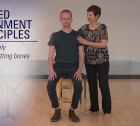Benefits and Research
The Alexander Technique attracts individuals wanting to improve mobility, ease postural discomfort, reduce chronic pain, and manage stress, while others seek lessons to advance their skills in the performing arts and athletic endeavours. Browse the menu lists below to learn more about how Alexander Technique can benefit you.
Use of resources
Please note that the content within the Research & Resources and Videos sections is provided only for general information purposes.
Use of Resources
Please note that the content within the Research & Resources is provided only for general information purposes. Many of the resources, such as books, are not free. Links to other websites or platforms are provided for viewers’ convenience, but ATC does not control or monitor them and accordingly cannot endorse their information or guarantee its accuracy and relevance. The use of content or links to third-party websites is at the viewers’ own risk. Viewers should contact an ATC-certified Alexander Technique teacher with any questions about the application of Alexander Technique to their specific issues.
Wind Instruments
- Benefits
- Resources
- Videos
- Testimonials
Wind instrumentalists who take Alexander Technique lessons soon realize how they may set up a series of faulty habits when they form their embouchure, hold their instrument, or even prepare to take a breath. As they become more self-aware and employ Alexander Technique principles, they can discover a whole new way of thinking and approach to their instrument.
Using their new-found awareness, some wind players may notice that they compress their torso and tighten their chest, shoulders, arms, neck, and face in an effort to push a high volume of air through their mouthpieces. The inefficiency of the embouchure muscles counters the goal of maintaining a sustained and even breath. Facial tension from the embouchure carries on through the rest of the body, hampering finger agility, articulation speed, the ability to take a fuller breath – ultimately limiting musical choices.
The energy required to produce a beautiful tone through the air pressure of the mouthpiece tends to get held in the upper body, divorcing it functionally from the rest of the body. The torso and legs are no longer able to do their job of properly supporting the entire body and wind instrumentalists find it difficult to remain “anchored.” These restrictive habits prevent their lungs from freely and fully taking a breath.
Alexander Technique encourages wind players to let go of their habitual tension and breathe expansively as their posture improves. They often find that the formation of their embouchure does not require as much pressure as they originally assumed. In many cases, they discover that their tone production becomes fuller and richer. Their newfound ease in coordination and movement facilitates musical freedom.
When you stop doing the wrong thing, the right thing does itself.
– F.M. Alexander
General Articles
I’ve taken Alexander Technique lessons for about three years. Not only have I found lessons to be a very enjoyable and rejuvenating part of my week, but they have also had a major impact on my practicing and performing. I no longer feel strain or tension in my wrists and I feel my risk of hurting myself from practicing is much lower. In performance, I feel more at ease physically and emotionally. I have a better understanding of how to use my body and not let it get in the way of a great show. Just like with learning an instrument, the best way to learn Alexander Technique is regular study with the best teacher you can find. In this case the instrument is your body!
– Dustin Finer, Saxophonist



